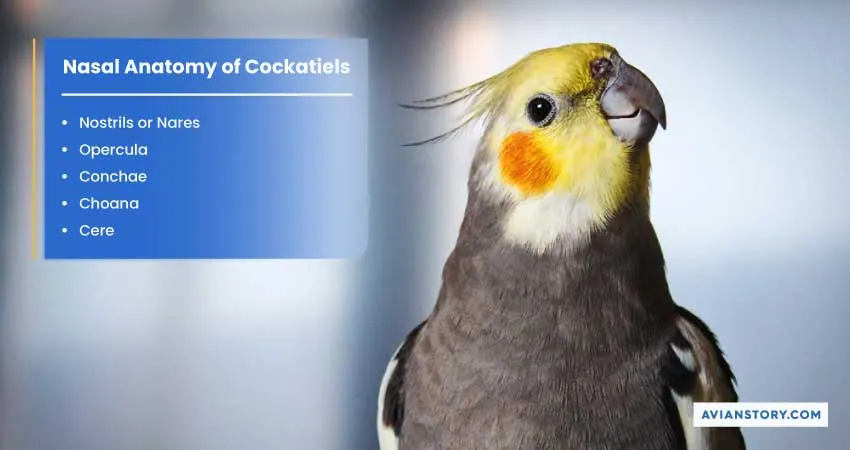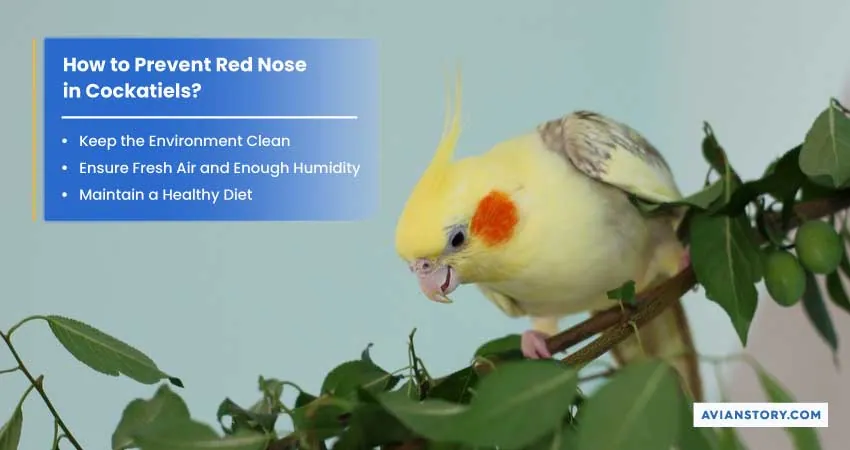Why Is My Cockatiels Nose Red? – 6 Reasons and Symptoms
Healthy cockatiels usually have dry and clean features around the nostrils. They can sneeze occasionally, but that will mostly be a dry sneeze. In some cases, there can be wet sneezing, and the features around the nose may turn red.
So, why is my cockatiels nose red? A red nose indicates an infected nasal passage in cockatiels. This can be caused by several health issues, such as bacterial or fungal infections, Chlamydophila, etc. Also, the bird can be stressed or injured when it bleeds from the nose, and the area may turn red.
Let’s explore all the causes behind the red nose in your cockatiels and know how to keep the birds healthy.
Nasal Anatomy of Cockatiels

Before we get to know why cockatiels’ noses can turn red, here is a quick look at the nasal anatomy of the bird.
- Nostrils or Nares – These are the openings of the respiratory tract. Usually, the nostrils are visible, and you can see the path inside the nostrils. But sometimes, they can be covered with feathers.
- Opercula – It is more like a flap that covers the inner openings of the respiratory tract. Although it may seem like a foreign body inside the nostrils, it actually prevents debris from passing through the tract.
- Conchae – Starting from the nostrils, it goes to the choana, and a mucous membrane lines the grooved structure.
- Choana – It is the internal opening of the nostril which opens into the nasal cavity. Nasal passages and sinuses meet here.
- Cere – This is a wax-like epidermis that is highly sensitive. The cere can be bare or covered by feathers.
6 Common Reasons Your Cockatiel’s Nose Is Red

Now that you have a brief idea about the respiratory system of the bird, we can now proceed to the reasons behind the nose of your bird being red.
Fungal or Bacterial Infections
Bacterial infections in the nostrils are very common in cockatiels. And they are highly prone to fungal or bacterial infections. This can turn their nose red, and you might even see nasal discharge.
The bacteria or fungus in the environment can easily reach the nostrils, especially when you run the air conditioner or the heater. As these machines are always on during summer or winter, the growth of bacteria or fungi can be high. If the room doesn’t have fresh air, the growth increases a lot.
In other cases, Vitamin A deficiency can also be a big reason behind this problem. When your bird doesn’t get enough Vitamin A, it makes the bird more prone to fungal or bacterial infections.
Foreign Bodies or Debris
From small food particles to dirt or feathers, anything can go inside the nasal passage. In most cases, cockatiels sneeze to remove those foreign bodies from their nostrils.
However, if the debris goes too deep inside the nasal passage, they might not be able to sneeze out of the body. And this is what causes infection in cockatiels.
Sinus Problems
The infection in infra-orbital sinuses can also cause red noses in cockatiels. Other than primary infections, secondary infections like Staphylococcus or Streptococcus can also happen.
This may have symptoms like frequent sneezing with thin or thick fluid discharge, red noses, or stained cere.
Mite Attack
Although the possibility of this is comparatively low, cockatiels can sometimes get attacked by mites. Birds living in dirty cages can be prone to mite attacks. In the primary stage, you will see red noses. As the plaque gets thicker, the skin above the nostrils will get brittle and can be sore often.
Low Humidity
Humid environments are the most suitable for cockatiels. When you run an air conditioner or heater in the room, they can lower the humidity level. So, if the air becomes too dry, cockatiels will be more prone to respiratory problems. Thus, this can be the cause of red noses in your cockatiels.
On the other hand, running humidifiers might not always be the solution as they can blow dust or bacteria if not cleaned for a long time.
Smoke Inhalation
Smoke can create multiple issues in your birds, including pneumonia and secondary infections. The bird can even die due to excessive inhalation of smoke. In that sense, if you smoke or vape in the room, respiratory issues can turn the nose of your bird red.
Symptoms of Nasal Infections

The symptoms of nasal infections may vary depending on the cause. You will see the following symptoms in an infected bird.
Nasal Discharge
You will see unusual nasal discharge if the bird has a bacterial, fungal, or sinus infection. In some cases, the fluid can be thin and clear, but it can be thick too.
Blocked Nasal Passage
When foreign bodies are stuck inside the nasal passage, your bird will have a hard time breathing. It might even choke if the foreign bodies or debris are too deep inside the nasal passage.
Swollen Nostrils
In the case of a viral infection, you will see swollen nostrils in cockatiels. The cere can turn red in such cases.
Loss of Appetite
If your bird is going through an infection, it might lose its appetite. Watch out for its feeding routine and see if the bird is eating enough food.
How to Prevent Red Nose in Cockatiels?

You can take multiple measures to keep your bird nose from turning red. Here is a quick list.
Keep the Environment Clean
This includes cleaning the bird’s cage as well as the room the bird lives in. Remove any food particles or debris from the case so that the bird can’t inhale them. And keep the room clean in order to prevent the growth of bacteria or fungus.
Ensure Fresh Air and Enough Humidity
A dry environment can be harmful to cockatiels. You should always keep the room humid to make the birds comfortable. Let fresh air pass into the room to keep your birds healthy.
Maintain a Healthy Diet
As we have already mentioned that vitamin deficiency can cause a red nose in cockatiels, you should follow a balanced diet chart. This is how your bird will get enough Vitamin A to boost the immune system.
Find the answer to frequently asked questions about red nose cockatiels.
How to clear the blocked nose of a cockatiel?
You need to use saline nose drops or nasal sprays to clear blocked nostrils.
How do cockatiels get vitamin A?
Cockatiels are highly dependent on seed diets which can cause them to face vitamin A deficiency. You should feed them with a lot of fruits and vegetables so that they get enough vitamin A.
Should I give vitamin supplements to treat red noses in cockatiels?
Consult with a vet before giving any supplements to your bird. In some cases, vets can suggest vitamin supplements.
Final Words
Red nose in cockatiels always makes the owner worry about the bird. Although it may not be something deadly, you should always address the problem as soon as possible and take the bird to a vet for a solution. However, as we always say, prevention is better than cure.
Next time when someone asks why is my cockatiel’s nose red, you can suggest them to look out for the above symptoms of inflammation or infection in cockatiels. The sooner you identify the problem and take measures to solve the problem, the healthier life your cockatiels will lead.
